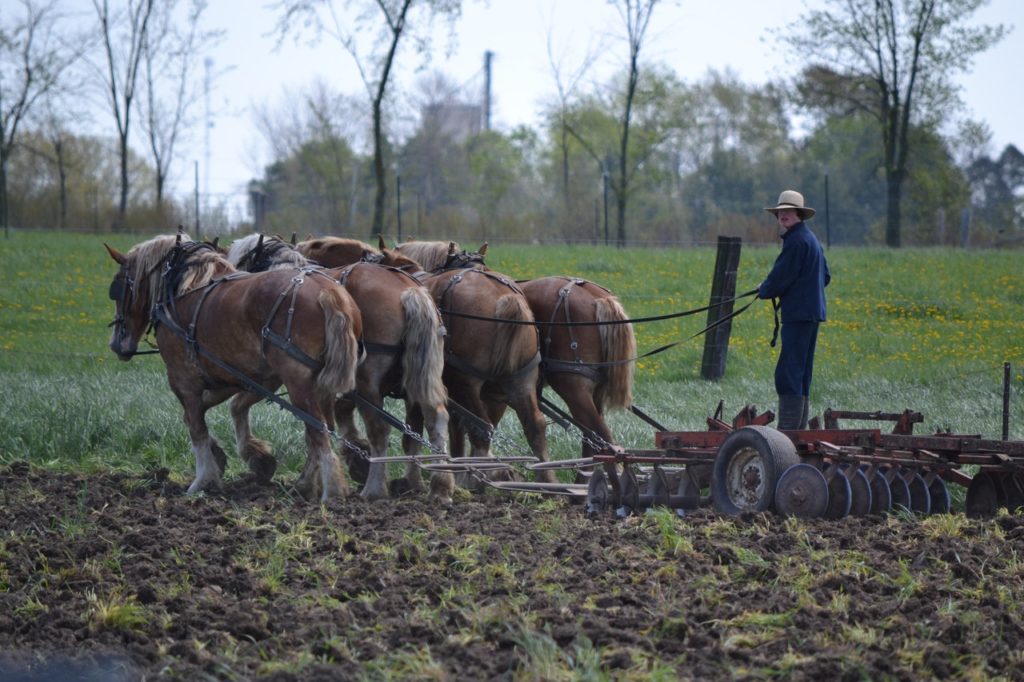
I learned this today. The horse collar changed society in a huge way and many things we take for granted now came about because of the horse collar.
There are different opinions, but humans probably started farming about 11,500 years ago. Many animals were domesticated at around this time as well. Fields were dug and crops were planted by hand. Labor was performed by people using digging sticks and hoes.
In about 6000 BC, oxen were domesticated in Mesopotamia. These are very powerful animals, and people realized that they could pull a great weight. A form of hoe was adapted to be pulled by an ox and the first ox-drawn plow (plough for my UK friends) was invented in about 3800 BC. Plows could have been around for longer, but 3800 BC is the earliest evidence found for plowing.
The plow evolved and spread around the world, but it was still pulled by oxen. Oxen are strong, but they move extremely slowly, and they tire easily. Horses were domesticated at about the same time as oxen. Horses are also strong, but they move much faster than oxen and have more stamina. However, horses couldn’t be used to plow fields because of the type of collar made for the plow.
The type of collar was called a yoke. It fitted over the head of the oxen and rested against the upper chest at the bottom and just in front of the shoulder blades at the top. Oxen have a lot of muscle here for the yoke to rest on. They also have short necks and a lower center of gravity, allowing them to easily pull a weight in this way. Horses are different to oxen. Horses have a higher center of gravity and a longer neck. Horses also don’t have much muscle on the front of their necks, so any yoke placed in the same way as on an ox would rest against the horse’s windpipe. This meant that horses would be pulling a heavy weight on their windpipes, which would suffocate them. The harder they pulled, the less they could breathe. It is hard to make an animal plow a field when it can’t breathe. So, oxen were used to plow fields.
That is, until the horse collar was invented in China in about 400 AD. This collar was padded, and it rested on the horse’s neck and shoulders without trapping the windpipe. The padding and the positioning meant that the weight was distributed evenly so the horse could use all of its strength and push forward with its back legs.
It took a while, but the horse collar made its way to Europe by 920 AD, and it was universally in use by the 12th century.
So, what changes did the invention of the horse collar bring to society?
When plowing with oxen, farmers can barely produce enough food to live, and farming was very much a subsistence industry. Horses can work roughly 50% faster than oxen. The efficiency of farmers skyrocketed, and they were suddenly able to produce more food than they needed. The first result of this was population growth. If people have more food, they are healthier, and it is possible to have more children. The second result was the food surplus meant that people had extra food that they could sell. This created markets, trading, and the merchant class. The invention of the horse collar was directly responsible for the eradication of the feudal system. Thirdly, farmers could farm more in less time, so they could specialize and focus on other skills. And lastly, using horses allowed people to live farther away from their fields. When using oxen, farmers had to live close to their fields. Horses can walk to and from the field, so farmers can live farther away. This allowed communities to become more centralized.
So, how did the invention of the horse collar affect society? It allowed farmers to produce 50% more food, eliminated the feudal system, created a merchant class, allowed farmers to specialize, increased the population, and allowed villages to centralize more. And this is what I learned today.
Sources
https://en.wikipedia.org/wiki/Yoke
https://en.wikipedia.org/wiki/Ox
https://en.wikipedia.org/wiki/Plough
https://www.thegreatcoursesdaily.com/medieval-farming-technology-transforms-europe/
https://www.barrons.com/articles/a-hat-tip-to-the-horse-collar-1400309246
https://en.wikipedia.org/wiki/Horse_collar

